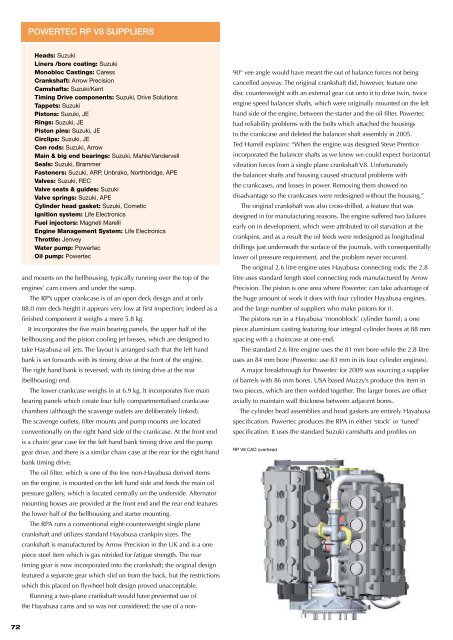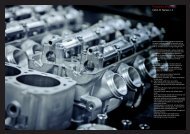Tom Sharp - Radical Performance Engines
Tom Sharp - Radical Performance Engines
Tom Sharp - Radical Performance Engines
You also want an ePaper? Increase the reach of your titles
YUMPU automatically turns print PDFs into web optimized ePapers that Google loves.
72<br />
POWERTEC RP V8 SUPPLIERS<br />
Heads: Suzuki<br />
Liners /bore coating: Suzuki<br />
Monobloc Castings: Caress<br />
Crankshaft: Arrow Precision<br />
Camshafts: Suzuki/Kent<br />
Timing Drive components: Suzuki, Drive Solutions<br />
Tappets: Suzuki<br />
Pistons: Suzuki, JE<br />
Rings: Suzuki, JE<br />
Piston pins: Suzuki, JE<br />
Circlips: Suzuki, JE<br />
Con rods: Suzuki, Arrow<br />
Main & big end bearings: Suzuki, Mahle/Vandervell<br />
Seals: Suzuki, Brammer<br />
Fasteners: Suzuki, ARP, Unbrako, Northbridge, APE<br />
Valves: Suzuki, REC<br />
Valve seats & guides: Suzuki<br />
Valve springs: Suzuki, APE<br />
Cylinder head gasket: Suzuki, Cometic<br />
Ignition system: Life Electronics<br />
Fuel injectors: Magneti Marelli<br />
Engine Management System: Life Electronics<br />
Throttle: Jenvey<br />
Water pump: Powertec<br />
Oil pump: Powertec<br />
and mounts on the bellhousing, typically running over the top of the<br />
engines’ cam covers and under the sump.<br />
The RP’s upper crankcase is of an open deck design and at only<br />
88.0 mm deck height it appears very low at first inspection; indeed as a<br />
finished component it weighs a mere 5.8 kg.<br />
It incorporates the five main bearing panels, the upper half of the<br />
bellhousing and the piston cooling jet bosses, which are designed to<br />
take Hayabusa oil jets. The layout is arranged such that the left hand<br />
bank is set forwards with its timing drive at the front of the engine.<br />
The right hand bank is reversed, with its timing drive at the rear<br />
(bellhousing) end.<br />
The lower crankcase weighs in at 6.9 kg. It incorporates five main<br />
bearing panels which create four fully compartmentalised crankcase<br />
chambers (although the scavenge outlets are deliberately linked).<br />
The scavenge outlets, filter mounts and pump mounts are located<br />
conventionally on the right hand side of the crankcase. At the front end<br />
is a chain/ gear case for the left hand bank timing drive and the pump<br />
gear drive, and there is a similar chain case at the rear for the right hand<br />
bank timing drive.<br />
The oil filter, which is one of the few non-Hayabusa derived items<br />
on the engine, is mounted on the left hand side and feeds the main oil<br />
pressure gallery, which is located centrally on the underside. Alternator<br />
mounting bosses are provided at the front end and the rear end features<br />
the lower half of the bellhousing and starter mounting.<br />
The RPA runs a conventional eight-counterweight single plane<br />
crankshaft and utilizes standard Hayabusa crankpin sizes. The<br />
crankshaft is manufactured by Arrow Precision in the UK and is a one<br />
piece steel item which is gas nitrided for fatigue strength. The rear<br />
timing gear is now incorporated into the crankshaft; the original design<br />
featured a separate gear which slid on from the back, but the restrictions<br />
which this placed on flywheel bolt design proved unacceptable.<br />
Running a two-plane crankshaft would have prevented use of<br />
the Hayabusa cams and so was not considered; the use of a non-<br />
90° vee angle would have meant the out of balance forces not being<br />
cancelled anyway. The original crankshaft did, however, feature one<br />
disc counterweight with an external gear cut onto it to drive twin, twice<br />
engine speed balancer shafts, which were originally mounted on the left<br />
hand side of the engine, between the starter and the oil filter. Powertec<br />
had reliability problems with the bolts which attached the housings<br />
to the crankcase and deleted the balancer shaft assembly in 2005.<br />
Ted Hurrell explains: “When the engine was designed Steve Prentice<br />
incorporated the balancer shafts as we knew we could expect horizontal<br />
vibration forces from a single plane crankshaft V8. Unfortunately<br />
the balancer shafts and housing caused structural problems with<br />
the crankcases, and losses in power. Removing them showed no<br />
disadvantage so the crankcases were redesigned without the housing.”<br />
The original crankshaft was also cross-drilled, a feature that was<br />
designed in for manufacturing reasons. The engine suffered two failures<br />
early on in development, which were attributed to oil starvation at the<br />
crankpins, and as a result the oil feeds were redesigned as longitudinal<br />
drillings just underneath the surface of the journals, with consequentially<br />
lower oil pressure requirement, and the problem never recurred.<br />
The original 2.6 litre engine uses Hayabusa connecting rods; the 2.8<br />
litre uses standard length steel connecting rods manufactured by Arrow<br />
Precision. The piston is one area where Powertec can take advantage of<br />
the huge amount of work it does with four cylinder Hayabusa engines,<br />
and the large number of suppliers who make pistons for it.<br />
The pistons run in a Hayabusa ‘monoblock’ cylinder barrel; a one<br />
piece aluminium casting featuring four integral cylinder bores at 88 mm<br />
spacing with a chaincase at one end.<br />
The standard 2.6 litre engine uses the 81 mm bore while the 2.8 litre<br />
uses an 84 mm bore (Powertec use 83 mm in its four cylinder engines).<br />
A major breakthrough for Powertec for 2009 was sourcing a supplier<br />
of barrels with 86 mm bores. USA based Muzzy’s produce this item in<br />
two pieces, which are then welded together. The larger bores are offset<br />
axially to maintain wall thickness between adjacent bores.<br />
The cylinder head assemblies and head gaskets are entirely Hayabusa<br />
specification. Powertec produces the RPA in either ‘stock’ or ‘tuned’<br />
specification. It uses the standard Suzuki camshafts and profiles on<br />
RP V8 CAD overhead



